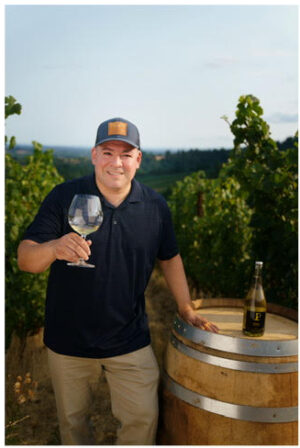By Kathleen Willcox
For decades, the Venn Diagram intersection of the Latinx and the wine communities happened solely in the vineyard. Slowly but surely, that’s changing — thanks to people like Sam Parra, who’s not only launched a winery but has also actively advocated to empower, educate and elevate Latinx members of the wine community in the vineyard and beyond. His efforts have landed him on Wine Industry Advisor’s 2024 list of Most Inspiring People.
 Parra, whose name means “grapevine” or “trellis” in Spanish and Portuguese, was born into the wine industry. “My grandparents came here as part of the Bracero program, and I grew up myself in and around Napa,” he says, referring to a farm labor agreement between Mexico and the United States, which brought millions of guest workers to the U.S. from 1942-1964.
Parra, whose name means “grapevine” or “trellis” in Spanish and Portuguese, was born into the wine industry. “My grandparents came here as part of the Bracero program, and I grew up myself in and around Napa,” he says, referring to a farm labor agreement between Mexico and the United States, which brought millions of guest workers to the U.S. from 1942-1964.
“I started to rise through the ranks myself in Napa and Sonoma, but ultimately, I knew I had to strike out on my own and go to a new place if I wanted to really make an impact.”
Like many second- and third-generation Americans, Parra wanted to honor the sacrifices his family made by leveling up.
“My family has been picking grapes, pruning vines and working in vineyards for two generations,” Parra says. “They wanted more for me. I decided I wanted to create a brand and make my own wine, but I felt like I had to leave California to do that.”
New Opportunities in New Terroirs
In 2016, Parra moved to the Willamette Valley, and began working and cultivating a network of contacts with growers and other folks in the wine business. In 2019, he launched Parra Wine Co. on a shoestring budget, releasing a line of small-batch, single vineyard wines sourced from the growers he connected with across Oregon.
The grape varieties are unexpected — Cabernet Franc, Gewürtztraminer and Tempranillo — and are often simultaneously a nod to Parra’s personal taste, and his roots.
“I really wanted to embrace and honor my Hispanic heritage, because I see that as part of my overall mission to change the perception of our culture and its role in wine culture,” Parra says. “So instead of producing a rosé, I make a rosado. I’m also releasing a canned hibiscus wine soon, and other canned wines are to come, because they’re letting us get wider distribution and they’re selling really well in upscale taquerias and among a younger generation of wine lovers.”
Producing terroir-driven, single vineyard wines that appeal to both younger and Latinx drinkers is important to Parra for multiple reasons.
“If the wine industry wants to grow, it needs to change its offerings and the way it communicates with people,” Parra says. “Younger people and people on a stricter budget are a lot more likely to grab a great can of wine. It’s more economical and, because they’re often drinking less, it is something they can finish in one night and not worry about hanging onto.”
They also want more than “just” single varietal wine, Parra says.
“Hibiscus-infused wine is something different, and it appeals to people who might not want a glass of traditional wine,” Parra says.
Balancing the Numbers
Parra’s drive to change the face of wine extends, quite literally, to who produces it.
“I got involved with AHIVOY [Asociación Hispana de la Industria del Vino en Oregon y Comunidad] when it was founded in 2019. Its goal is to help elevate the careers of vineyard stewards who want to grow their skills or perhaps even transition and create a brand of their own,” Parra says. “There is so much hard work that goes into working in the vineyards, and there have traditionally been very few pathways to go beyond that.”
Parra and the nonprofit AHIVOY team offer educational and professional development to vineyard stewards in Oregon through Chemeketa Community College. The program also offers an English immersion course and pathways to career growth and educational opportunities.
Without AHIVOY’s assistance, the dozens of folks who have benefited personally and professionally from the immersive courses would never have been able to afford to fund them.
“There is no hereditary wealth for me or the other vineyard stewards out there,” Parra says. “Most wineries are founded by people with hereditary wealth. I was lucky to be able to save enough money to begin my own brand, but to expand it, I also needed help.”
Indeed, while the rate of Hispanic-owned businesses has grown, it does not reflect the population of Hispanics in the United States. The Census Bureau’s latest numbers show that Hispanic-owned businesses grew 8.2% from 346,836 in 2019 to 375,256 in 2020, to make up about 6.5% of all businesses in the country. And of the estimated 11,600+ wine brands in the U.S., Parra estimates that just over 100 are Hispanic-owned.
The U.S. Hispanic population, meanwhile, is about 19.1% of the country’s total population. To make matters more challenging for up-and-coming Hispanic business owners, less than 1% of all funding from top venture capital firms goes to Latinx-owned businesses.
Recognizing Innovation
To counterbalance all of these challenges, Oregon-based serial entrepreneur Juan Barraza created Latino Founders so he could fund and empower the next generation of Latinx entrepreneurs.
“We developed [accelerator program] Pitch Latino to provide an opportunity for entrepreneurs to get funding for their projects and scale up so that they might be more attractive to larger venture funds down the line,” Barraza explains of the event that distributed funding to Hispanic-owned businesses in Oregon, adding that each of the nine entrepreneurs who participated applied before earning the opportunity to pitch in October 2023.
“We’re really excited about Sam’s projects because he did a great job of showing how the current wine industry isn’t connecting with younger generations,” Barraza says. “He’s looking to the future and creating wines for people who want different flavors, want to consume less and want a recyclable container.”
With the $2,500 grant he received, Parra will be able release more canned wines this year and look to grow the distributor base.
“I produced 4,500 cans in 2023, and my goal in 2024 is 10,000,” he says. “We saw a lot of success last year with canned wine, and I really see it as the future.”
____________________________________________________________________
 Kathleen Willcox
Kathleen Willcox
Kathleen Willcox writes about wine, food and culture from her home in Saratoga Springs, N.Y. She is keenly interested in sustainability issues, and the business of making ethical drinks and food. Her work appears regularly in Wine Searcher, Wine Enthusiast, Liquor.com and many other publications. Kathleen also co-authored a book called Hudson Valley Wine: A History of Taste & Terroir, which was published in 2017. Follow her wine explorations on Instagram at @kathleenwillcox


















